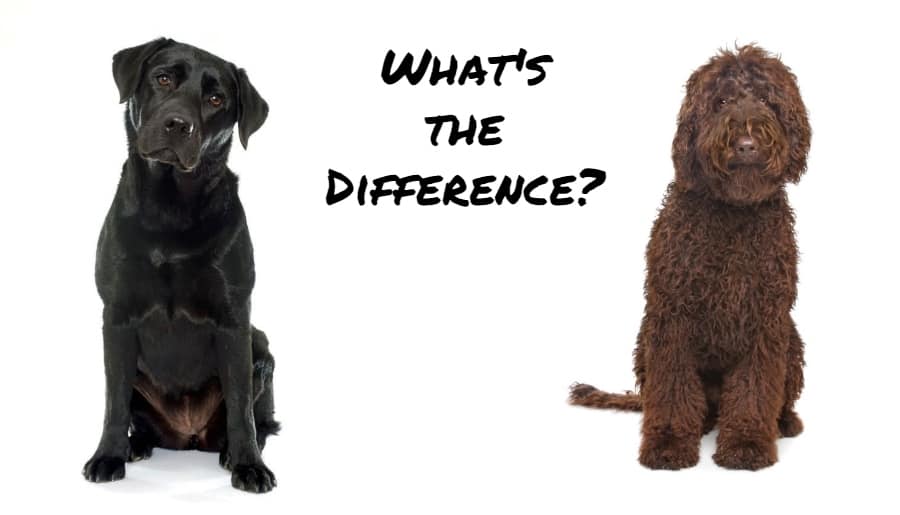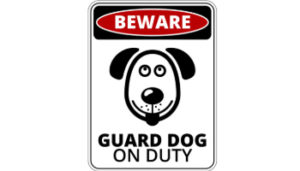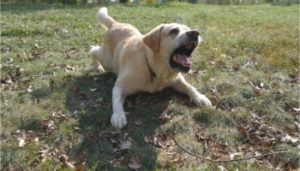
When I first pondered the idea of getting a new dog, I knew I wanted a Labrador for sure, but what I didn’t know was what type of the breed I truly want. So, I rolled up my sleeves and started doing a little digging until I came across a Labradoodle. From here I had to know more about how a Labradoodle differed from a traditional Labrador. After some research, I found out quite a bit of interesting differences between the breeds that can help spot the key variances of the breeds, right off bat.
What’s the difference between Labrador and Labradoodle? As the name suggests, a Labradoodle is a hybrid, bred from a purebred Poodle and Labrador Retriever! The Labradoodle share different characteristics inherited by both of its parents in terms of size, coat, intelligence, mannerism, and other traits.
Labradoodles come in all sorts of shapes, sizes, fur types and even colors. Since a Labradoodle is a cross between a Labrador and Poodle, one can expect Labradoodle pups to exhibit a variety of traits passed down from its parents. When learning to spot the differences between a Labrador and Labradoodle there are a lot of fun and interesting facts that can help you spot the difference and save time.
What’s the Difference Between Labrador and Labradoodle?
While both breeds are considered highly intelligent, they each bring their own unique set of traits to the table. In order to clearly understand the difference between the two, it’s best to get a good grasp on each of its breed characteristics.
The Labrador Retriever did not come from Labrador but instead originated in Newfoundland, commissioned as a duck retriever and a suitable fishing boat mate. The early earls and lords visiting Canada during the late 1700s and early 1800s brought this breed back to Great Britain, where they would continue to refine the Labrador’s amazing physical and mental attributes.
A purebred Labrador has a very defining stance, visual appeal, and mannerism along with a set of refined physical features that make the Lab what it is. This is where the Lab comes from in Labradoodle. Labs have a powerful stance, short-coupled and a thick tapering tail that is known as an “otter tail.” Regionally the coats of a Labrador will vary from a weather-resistant medium length coat to a short and sleek water-resistant coat.
Today, Labradors typically possess the short and sleek double-coat, while the longer coats are more generally associated with Golden Retrievers. The thick paddle-like tail of the Lab allows it to easily maneuver in water while swimming during water-based retrieval activities.
One thing to keep in mind about labs is the amount of energy they possess. Labradors are extremely energetic and require lots of regular exercis. This can range from decent long runs and long periods of exhausting fetch games. When Labs are under stimulated they may start to show signs of destructive behavior to release their pent-up energy. Alternatively, Labs can become hyperactive if they do not get the right amount of exercise.
Types of exercises enjoyed by Labrador Retrievers:
- hiking trips
- fetch swimming
- agility, obedience, and tracking sports
Alternatively, Labradors are considered amonth one of the most friendliest dogs and has been a top contender according to the AKC for over 20 years. One major role that Labs play is their knack for being top-rated service dogs. These canine services can range and are not limited to these top services Labs are best known for:
- emotional support dogs
- search-and-rescue
- bomb detection
- mobility assistance
The standard Labrador is between 21.5 inches to 24.5inches with the larger sizes being touted by the male specimen and can weigh anywhere from 55-90 pounds with a life expectancy of 10-12 years.
The other half of a Labradoodle is the Poodle. While Labs are considered friendly, active and outgoing with a high level of intelligence, Poodles carry themselves with pride and are considered to be very active, proud and possess superior intelligence when compared to other breeds.
Originally, the breed came from Germany, not France where it was bred as a duck hunter, which is also where the word Poodle stems from: The splashing in water is referred to as pudelin.
Sure, the idea of Poodles may sound a little sissy and in the early days did showcase a stereotype of sorts, but Poodles are anything but schoolyard wimps. What many people do not know is that Poodles were originally bred as incredible retrievers whose coat and build allowed maximum mobility on water or land, whether facing cold, wet, or warm weather conditions.
Not only are the looks different from its Labrador counterpart; it also has different inheritable traits. Despite the similar character traits like retrieval, intelligence and loyalty, Poodles come with a very different fur coat. Commonly referred to as fleece, the unusual hairstyles of a shaved neck, legs, and tail are not for aesthetics, but serve a more practical purpose. The remaining round balls of fluff left on a Poodle’s legs, hips and tail tip are referred to as pompons. This is totally different from the pom-poms cheerleaders motivate crowds with.
The crisp, curly fur of a Poodle protects it against harsh weather and is in complete contrast to that of a Labrador’s. A Poodle’s energy level is just as high as a Labs, meaning it does require a good amount of daily activity to exert any built-up energy. Poodles are not just attracted to running and fetching exercise, but rather enjoy a wide variety of activities. However, being bred as a hunting dog, Poodles do enjoy some of the same exercise activities as Labs:
- swimming
- fetching
- walks and/or light jogs
Poodles, on the other hand, are rarely seen as service dogs and are present in more elegant fashions to take advantage of their proud and remarkably proud stance.
Some featured characteristics of the Poodle are its slim but muscular build that is both sleek, thin, and tightly built in a square fashion across the body.
Standard Poodles stand over 15 inches tall from the shoulder, while miniatures fall below 15 inches. For miniatures, the type specimen weight is between 10-15 pounds for both male and female. For standard Poodles, males will typically hit the 60-70 pound mark while the smaller female will be around 40-50 pounds.
You would think that the mixing of two excellent hunting breeds would result in a superior, well-behaved, loyal hunting dog. However, the Labradoodle’s main attraction is its low-shedding and highly intelligent mannerisms as an exceptional service dog, which was its original reason for combining the two smart and active breeds.
Since it was bred as a hypoallergenic service dog, Labradoodles have started to gain popularity in the service dog industry. However, there are still some kinks to work out with the shedding of the breed as it is not considered hypoallergenic due to its Labrador like shedding.
Now that we understand the parents a little better, what is there to know about the Labradoodle itself? Lots actually. If you paid any attention in biology, then you may remember a word called genes. These are physical and nonphysical attributes passed down from parents to offspring. Do you have any siblings? Do all of you look the same and act the same as well? There is a reason for that and it’s all about genetics. You are breeding a fluffy fleece coated dog with a short to mid-length fur canine; you better believe there are going to be some serious variations here. What parent was considered dominant and which one recessive?
This is where it gets tricky when spotting what the differences are between a Labrador and Labradoodle. You have one purebred and one hybrid that could display some purebred features. I learned so much in such a short time about the difference between the two. Here’s what I found out about Labradoodles:
- Desired for its light-shedding coat
- Extremely adaptable for apartment living
- ighly intelligent and versatile service dog
- Amazing with kids and families
- Their coat does not always come out hypoallergenic like the Poodle’s fur
While the desired result of breeding the two was to get a hypoallergenic service dog, the coats of the Labradoodle vary. They can have short sleek hair like the Labrador, medium wavy/wire-like hair or curly hair similar to the Poodle. The differences really can vary as the genetics of the parents will play a part of the outcome of the litter. As a standard for identifying the difference between a Labrador and Labradoodle, I’ve made a small table to compare differences:
| Breed/Feature | Labrador | Labradoodle | Poodle |
|---|---|---|---|
| Trainability: | Easy | Easy | Easy |
| Coat: | Short, Sleek, Water-Resistant | Short/Medium/Fleece/Water-Resistant/Varied | Fleece, Water-Resistant |
| Size: | 21.5-24.5 inches | 14-24 inches (Poodle Parent Dependent) | 15+ inches |
| Weight: | 55-80 pounds | 15-65 pounds (Poodle Parent Dependent) | 40-70 pounds |
| Hypoallergenic: | No | Yes/No | Yes |
What type of Fur Will My Labradoodle Have?
This is a great question and there are a series of complicated and technical breeding tactics that can do fairly well at gauging what the offspring will be like, however, there are no guarantees. Your Labradoodle can have a variety of hair types. This is mainly due to the nature of the hybrid and the selected parents along with the generational degree of the said Labradoodle breed.
What do generations have to do with a Labradoodle’s coat?
Labradoodles can come in a wide range of colors and coat types, many of these are determined by the generation of the breed. Is it a first gen? Second? Perhaps it is a 3rd generation, but what do these complicated genetic terms have to do with the outcome of a Labradoodle?
A Labradoodle can gain attributes through inheritable traits from either or both parents. This means that it can have the nice short double-coat of a Lab, the thick curly coat of a Poodle, or a mixed fleece-style coat, which can also look curly or wavy.
Let’s see how generations can affect the coat of a Labradoodle:
| 1st Generation (F1) | 2nd Generation (F1b) | 3rd Generation (F1b.b) |
|---|---|---|
| shaggy shedding coat | Fleecey Low-shedding coat | Poodle-like coat/Lab-like personality |
This alone can help distinguish the difference from a Labrador, as the coats will typically be longer than a purebred Lab’s coat.
Is Grooming a Labradoodle Easy?
Everyone enjoys having a faithful companion, but when it comes time for fur maintenance, many of us run for the hills. Owning a Labrador alone requires some maintenance. While you will not have to worry about matting, you will have annual sheddings when dealing with a Labrador. All in all, a Labrador’s coat will take care of itself. Unfortunately, a Labradoodle’s coat will require some hands-on love and time.
Even first generation Labradoodles that share a resemblance to their Lab side more will still need regular grooming to prevent matting and to removing fur that is caught from shedding. Second generations or older still need to be groomed regularly. This is especially important because the curly hair is more refined and closer to that of a Poodle’s coat.
It’s recommended to give second and older generations daily brushings and at least monthly grooming appointments with a professional.
Labradoodles have a unique coat and while it does shed, depending on the generation of the pup, grooming can be simple, intermediate, or rather difficult. It is best to determine which hairstyle you would prefer and then check to see if the grooming requirements for that particular Labradoodle will fit the needs you can provide it with.
I know there are a lot of other questions that can spawn from reading this. I’ve tried to answer a few of them based on my research to assist in looking at the differences between a Labrador and Labradoodle:
What are common diseases inherited by Labradoodles?
- Hip dysplasia
- Elbow dysplasia
- PRA (progressive blindness)
How long do Labradoodles live?
Labs live to be around 12 years, and Poodles can live to be 10-18 years, with smaller Poodle breeds living longer than larger ones. With that said, Labradoodles can expect to live approximately 12 years and with a healthy diet, proper exercise, and a balanced lifestyle maybe even longer.
How much is a Labradoodle?
- Around $1,000 for F1 Doodles
- Around $1,500 for parti or Apricot Doodles
- Around $2,500 for Third Gen. or older low-shedding coat Doodles
- Around $3,000 for Australian Doodles
What are the main maintenance concerns for owning a Labradoodle?
While dogs are fairly good at adapting to their environment, Labradoodle owners do have to keep exercise, living space
What are exercise requirements for Labradoodles?
Since both Labradors and Poodles are more susceptible to hip dysplasia, it’s vital to ensure they have a proper diet and the right amount of exercise. Labradoodles come from highly energetic breeds and owners should be ready to help them exert their high levels of energy.
What’s the best type of food for a Labradoodle?
Generally, a high-quality commercial brand of dog food is suitable. Some owners prefer a homemade diet with the assistance of their vet or trainer.
What colors do Labradoodles come in?
- Apricot (rare)
- Black
- Blue
- Brown
- Cream
- Gray
- Red
- Silver
- Silver Beige
- White



